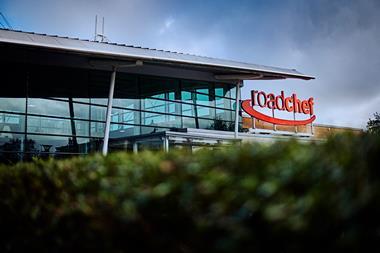Under new government plans, trucks are set to grow in length. Supermarkets point to the potential for efficiency gains and CO2 reductions, but not everyone is convinced. Adam Hill reports
Is big trouble looming in little Britain over the arrival of the super-truck? The maximum permissible weight has already crept up from 32 tonnes to 44 over the past two decades and if the government gets its way, they could increase in size yet again.
A Department for Transport (DfT) consultation launched this March floated the possibility of adding another 2.05m to the current maximum length for a semi-trailer of 13.6m. The move would increase the maximum length of the tractor unit-plus-trailer to 18.75m allowing one truck to do the work currently done by two.
For the supermarkets, many of whom have benefitted from a recent move to double decker trucks, longer trucks present a mouth-watering proposition and Morrisons and Waitrose are already hailing the potential financial and environmental savings. "Longer trailers would produce only a fractional increase in carbon emissions but a significant increase in load capacity, of up to 15%," says a Waitrose spokesman.
But not everyone is convinced the impact of the super-truck will be benign and some question whether it will have any impact at all cue mounting tension between the pro and anti super-truck camps .
In the pro corner are those who are adamant that the boost in capacity will lead to major improvements in distribution efficiency. They point out that the change would mean a 15% hike in capacity for pallets and 20% for cages.
That potentially equates to a maximum load increase from the current 26 pallets to 30, or from 45 UK standard retail cages to 54. Given that trucks used for grocery can fill their cubic capacity well before they get near the 44-tonne weight limit, that extra space is useful to say the least.
It's not just the potential cost savings associated with this increased capacity that are whetting the appetite. The environmental argument is also strong: logistics group Wincanton estimates the switch could save the logistics industry £1.8bn in fuel costs each year and cut CO2 emissions by 3.7 million tonnes. The extra space would also give transport companies more scope to deliver to multiple customers at the same time, says Richard Butcher, deputy CEO at Stobart Group.
"It gives us more opportunity to consolidate on ambient goods," he explains. "Deliveries used to be day one for day three but a move to day one for day two has been driven by the major retailers. They want more deliveries, more frequently. The extra length would allow us to cross-dock."
The projected productivity improvements and carbon footprints are not enough to appease the naysayers though. They argue that the change could do more harm than good. For one, there are concerns about how much additional "outswing" an extra 2.05m would generate at the back of a trailer. Detractors warn that it would be significantly greater, posing a hazard to other motorists on the road and making the trucks harder for drivers to handle.
Wincanton technical services director Dave Rowlands agrees that driver training and awareness campaigns will be needed but insists that outswing is not a major issue. Stobart, meanwhile, says it has tested its own prototypes and claims there are no significant safety concerns.
Other cheerleaders for the extra 2.05m point out that the new length is already seen on UK roads in the form of the so-called "drawbar" (rigid truck plus trailer) combinations. "We have vehicles carrying 30 pallets running at that extended length now, albeit in a slightly different form," explains Butcher.
However, Philippa Edmunds, manager of pressure group Freight On Rail counters that drawbars only make up a small percentage of the UK vehicle parc at present and unless payload utilisation is increased, a change in length would simply mean larger lorries driving around carrying less cargo and causing more pollution.
Edmunds is one of a growing group of people who are opposed to the proposed changes. "There are safety issues such as tail swing and stability and these trucks will also undermine low-carbon alternatives," she maintains. "In theory, you could get more cargo on but you have to ask about existing efficiencies: how much empty running do supermarkets do now?"
Making road transport even more attractive is not the way forward, agrees Stephen Joseph, chief executive of the Campaign for Better Transport. "Introducing longer HGVs will further damage this government's green credentials and undermine efforts to adopt rail as a more sustainable, safer and environmentally sensible way to move freight," he argues.
"If the government allows this increase it could be the tip of the iceberg with so-called megatrucks just around the corner." Fail to put up a fight now, he warns, and one day we could see even larger vehicles of 25.5m in length and up to 60 tonnes in weight on the UK's roads.
Rail Freight Group chairman Tony Berkeley is similarly concerned. "If the government really wants to address road congestion and greenhouse gas emissions from logistics, then discouraging hauliers from considering rail, thereby limiting rail's future growth in the retail sector, is a seriously retrograde step," he says.
It may be no great surprise that railfreight bodies are not in favour of longer lorries, but some hauliers are not overwhelmed by the prospect, either.
While the Freight Transport Association (FTA), which represents thousands of logistics companies, is firmly behind the move, the position of rival trade body the Road Haulage Association (RHA) is less black and white. "We have a lot of members in favour, and a lot against," says director of policy Jack Semple.
One reason the bodies don't see eye to eye is that they have very different opinions on how popular super-trucks would be. Andy Mair, FTA head of engineering policy, believes that even if they are given the green light, their impact will be minimal. "Not all operators running artics will go out and buy these trailers," he argues. "The majority of carriers are expected to remain at existing trailer lengths."
Similarly, Wincanton's Rowlands thinks the new longer trailers will mainly be used in operations between distribution centres or to out-of-town stores. "I don't see these trailers going 'inner urban'," he says.
The RHA, however, does, despite members' concerns around issues such as trailer outswing and stability. "This is very likely to become the new standard length for artics in the UK," says Semple. "In grocery, there will be strong demand for it. But shippers and receivers of goods not just in grocery don't make efficient use of the dimensions already available to them."
The association also cautions that while this new breed of super-truck should work well for high-volume, lightweight work such as grocery distribution, it may not be so much use for general haulage.
These customers would have to be catered for, however. So if the 15.65m trailer becomes the de facto choice for the grocery industry, many road transport operators could find themselves saddled with kit that while demanded by some customers for some contracts costs more to buy, takes more fuel to run and is not fully utilised most of the time.
This could cripple an industry already damaged by the escalating cost of fuel. Some haulage companies are therefore advocating a compromise. Stobart would prefer an increase in length of one metre, rather than two. This would still provide capacity for 28 pallets as opposed to 26, and 51 rollcages instead of 45 but would give the company "more flexibility for general haulage", claims Butcher.
It's still unclear exactly what operational changes the DfT's proposal will herald. The consultation runs until late June and if the plan is given the green light, it's anticipated that longer trucks could hit the UK road network as early as next year.
Even if the proposal is rejected, it's not going to stop the rise of the super-truck. There are currently no plans to introduce a height limit for trucks in the UK, which means there's plenty of opportunity for logistics groups and the multiples to further invest in double-decker trailers.
Morrisons CEO Dalton Philips recently described the savings from such vehicles as "spectacular". The retailer introduced them to its fleet 18 months ago and expects to run 80 by the year-end. While most of the work the double-decker fleet undertakes is between plants and depots, last year Morrisons completed a "successful" trial using them to deliver to its Isle of Wight stores. "We have plans to extend that to more stores during 2011," a spokesman says.
Morrisons isn't alone. "We've purchased 28 over the past year," says Sainsbury's logistics operations support manager Gary King. "There are benefits in reducing fuel usage and maximising resources. They are cost-effective if used correctly."
As with any piece of equipment, double-decks still have to be used for the right job, warns King. "If they are used inefficiently, they can cost money due to reducing backhaul opportunities," he explains.
But get it right and the rewards are attractive. Just ask logistics provider NFT. On a contract to supply M&S with fresh sandwiches, the company has cut food miles by more than 30%. Tesco says it has enjoyed similarly impressive results from double-decks. It has saved 12.5 million road miles and 16,912 tonnes of C02 by using them, and intends to increase their use.
Meanwhile, Asda, which put double-decks into its fleet in February 2010, estimates carbon emissions will be cut by 4,700 tonnes a year, with 70% improved fill over single-deck trailers. It also anticipates saving 3.6 million road miles, 1.8 million litres of fuel and up to £5.2m a year.
The case for longer trucks is equally compelling, believe the mults. If the government pushes the proposals through, we'll find out if they're right. But with double-decks already making their mark, regardless of whether or not trucks get longer, one thing's for certain they're about to get a helluva lot bigger.
Logistics:UK vs USA
Fuel prices
UK: The UK has just hit a record high for diesel prices. On 5 May, Petrolprices.com recorded 143.04ppl as the national average. Hauliers buying in bulk were paying 114.93ppl before VAT, according to a survey on 8 April. In 2000, when hauliers protested at the high diesel price, the peak was about 70ppl. Since the start of 2010 there has been a 22.3% increase via duty and commercial rises.
Source: Road Haulage Association
USA: This year it is predicted the US trucking sector will spend $135.8bn on 35 billion gallons of diesel ($3.88 per gallon or 62ppl) $35bn more than last year. In the first quarter of 2011, fuel has increased by about 60c per gallon. The average nationwide price of diesel bought on the highway in 2009 was $2.437/gallon. That is 64c (39p) per litre. In March that year, the price fell to a four-year low of $2.017/gallon: 32ppl. But in 2008 it reached a peak of $4.764/gallon.
Source: The American Trucking Associations
Dimensions
UK:
Overall truck and trailer length: 16.5m
Maximum weight: 44 tonnes
Pallet capacity: 26
USA:
Overall truck, up to two trailers: 19.2m
Maximum weight: 36 tonnes
Pallet capacity: 34
Is big trouble looming in little Britain over the arrival of the super-truck? The maximum permissible weight has already crept up from 32 tonnes to 44 over the past two decades and if the government gets its way, they could increase in size yet again.
A Department for Transport (DfT) consultation launched this March floated the possibility of adding another 2.05m to the current maximum length for a semi-trailer of 13.6m. The move would increase the maximum length of the tractor unit-plus-trailer to 18.75m allowing one truck to do the work currently done by two.
For the supermarkets, many of whom have benefitted from a recent move to double decker trucks, longer trucks present a mouth-watering proposition and Morrisons and Waitrose are already hailing the potential financial and environmental savings. "Longer trailers would produce only a fractional increase in carbon emissions but a significant increase in load capacity, of up to 15%," says a Waitrose spokesman.
But not everyone is convinced the impact of the super-truck will be benign and some question whether it will have any impact at all cue mounting tension between the pro and anti super-truck camps .
In the pro corner are those who are adamant that the boost in capacity will lead to major improvements in distribution efficiency. They point out that the change would mean a 15% hike in capacity for pallets and 20% for cages.
That potentially equates to a maximum load increase from the current 26 pallets to 30, or from 45 UK standard retail cages to 54. Given that trucks used for grocery can fill their cubic capacity well before they get near the 44-tonne weight limit, that extra space is useful to say the least.
It's not just the potential cost savings associated with this increased capacity that are whetting the appetite. The environmental argument is also strong: logistics group Wincanton estimates the switch could save the logistics industry £1.8bn in fuel costs each year and cut CO2 emissions by 3.7 million tonnes. The extra space would also give transport companies more scope to deliver to multiple customers at the same time, says Richard Butcher, deputy CEO at Stobart Group.
"It gives us more opportunity to consolidate on ambient goods," he explains. "Deliveries used to be day one for day three but a move to day one for day two has been driven by the major retailers. They want more deliveries, more frequently. The extra length would allow us to cross-dock."
The projected productivity improvements and carbon footprints are not enough to appease the naysayers though. They argue that the change could do more harm than good. For one, there are concerns about how much additional "outswing" an extra 2.05m would generate at the back of a trailer. Detractors warn that it would be significantly greater, posing a hazard to other motorists on the road and making the trucks harder for drivers to handle.
Wincanton technical services director Dave Rowlands agrees that driver training and awareness campaigns will be needed but insists that outswing is not a major issue. Stobart, meanwhile, says it has tested its own prototypes and claims there are no significant safety concerns.
Other cheerleaders for the extra 2.05m point out that the new length is already seen on UK roads in the form of the so-called "drawbar" (rigid truck plus trailer) combinations. "We have vehicles carrying 30 pallets running at that extended length now, albeit in a slightly different form," explains Butcher.
However, Philippa Edmunds, manager of pressure group Freight On Rail counters that drawbars only make up a small percentage of the UK vehicle parc at present and unless payload utilisation is increased, a change in length would simply mean larger lorries driving around carrying less cargo and causing more pollution.
Edmunds is one of a growing group of people who are opposed to the proposed changes. "There are safety issues such as tail swing and stability and these trucks will also undermine low-carbon alternatives," she maintains. "In theory, you could get more cargo on but you have to ask about existing efficiencies: how much empty running do supermarkets do now?"
Making road transport even more attractive is not the way forward, agrees Stephen Joseph, chief executive of the Campaign for Better Transport. "Introducing longer HGVs will further damage this government's green credentials and undermine efforts to adopt rail as a more sustainable, safer and environmentally sensible way to move freight," he argues.
"If the government allows this increase it could be the tip of the iceberg with so-called megatrucks just around the corner." Fail to put up a fight now, he warns, and one day we could see even larger vehicles of 25.5m in length and up to 60 tonnes in weight on the UK's roads.
Rail Freight Group chairman Tony Berkeley is similarly concerned. "If the government really wants to address road congestion and greenhouse gas emissions from logistics, then discouraging hauliers from considering rail, thereby limiting rail's future growth in the retail sector, is a seriously retrograde step," he says.
It may be no great surprise that railfreight bodies are not in favour of longer lorries, but some hauliers are not overwhelmed by the prospect, either.
While the Freight Transport Association (FTA), which represents thousands of logistics companies, is firmly behind the move, the position of rival trade body the Road Haulage Association (RHA) is less black and white. "We have a lot of members in favour, and a lot against," says director of policy Jack Semple.
One reason the bodies don't see eye to eye is that they have very different opinions on how popular super-trucks would be. Andy Mair, FTA head of engineering policy, believes that even if they are given the green light, their impact will be minimal. "Not all operators running artics will go out and buy these trailers," he argues. "The majority of carriers are expected to remain at existing trailer lengths."
Similarly, Wincanton's Rowlands thinks the new longer trailers will mainly be used in operations between distribution centres or to out-of-town stores. "I don't see these trailers going 'inner urban'," he says.
The RHA, however, does, despite members' concerns around issues such as trailer outswing and stability. "This is very likely to become the new standard length for artics in the UK," says Semple. "In grocery, there will be strong demand for it. But shippers and receivers of goods not just in grocery don't make efficient use of the dimensions already available to them."
The association also cautions that while this new breed of super-truck should work well for high-volume, lightweight work such as grocery distribution, it may not be so much use for general haulage.
These customers would have to be catered for, however. So if the 15.65m trailer becomes the de facto choice for the grocery industry, many road transport operators could find themselves saddled with kit that while demanded by some customers for some contracts costs more to buy, takes more fuel to run and is not fully utilised most of the time.
This could cripple an industry already damaged by the escalating cost of fuel. Some haulage companies are therefore advocating a compromise. Stobart would prefer an increase in length of one metre, rather than two. This would still provide capacity for 28 pallets as opposed to 26, and 51 rollcages instead of 45 but would give the company "more flexibility for general haulage", claims Butcher.
It's still unclear exactly what operational changes the DfT's proposal will herald. The consultation runs until late June and if the plan is given the green light, it's anticipated that longer trucks could hit the UK road network as early as next year.
Even if the proposal is rejected, it's not going to stop the rise of the super-truck. There are currently no plans to introduce a height limit for trucks in the UK, which means there's plenty of opportunity for logistics groups and the multiples to further invest in double-decker trailers.
Morrisons CEO Dalton Philips recently described the savings from such vehicles as "spectacular". The retailer introduced them to its fleet 18 months ago and expects to run 80 by the year-end. While most of the work the double-decker fleet undertakes is between plants and depots, last year Morrisons completed a "successful" trial using them to deliver to its Isle of Wight stores. "We have plans to extend that to more stores during 2011," a spokesman says.
Morrisons isn't alone. "We've purchased 28 over the past year," says Sainsbury's logistics operations support manager Gary King. "There are benefits in reducing fuel usage and maximising resources. They are cost-effective if used correctly."
As with any piece of equipment, double-decks still have to be used for the right job, warns King. "If they are used inefficiently, they can cost money due to reducing backhaul opportunities," he explains.
But get it right and the rewards are attractive. Just ask logistics provider NFT. On a contract to supply M&S with fresh sandwiches, the company has cut food miles by more than 30%. Tesco says it has enjoyed similarly impressive results from double-decks. It has saved 12.5 million road miles and 16,912 tonnes of C02 by using them, and intends to increase their use.
Meanwhile, Asda, which put double-decks into its fleet in February 2010, estimates carbon emissions will be cut by 4,700 tonnes a year, with 70% improved fill over single-deck trailers. It also anticipates saving 3.6 million road miles, 1.8 million litres of fuel and up to £5.2m a year.
The case for longer trucks is equally compelling, believe the mults. If the government pushes the proposals through, we'll find out if they're right. But with double-decks already making their mark, regardless of whether or not trucks get longer, one thing's for certain they're about to get a helluva lot bigger.
Logistics:UK vs USA
Fuel prices
UK: The UK has just hit a record high for diesel prices. On 5 May, Petrolprices.com recorded 143.04ppl as the national average. Hauliers buying in bulk were paying 114.93ppl before VAT, according to a survey on 8 April. In 2000, when hauliers protested at the high diesel price, the peak was about 70ppl. Since the start of 2010 there has been a 22.3% increase via duty and commercial rises.
Source: Road Haulage Association
USA: This year it is predicted the US trucking sector will spend $135.8bn on 35 billion gallons of diesel ($3.88 per gallon or 62ppl) $35bn more than last year. In the first quarter of 2011, fuel has increased by about 60c per gallon. The average nationwide price of diesel bought on the highway in 2009 was $2.437/gallon. That is 64c (39p) per litre. In March that year, the price fell to a four-year low of $2.017/gallon: 32ppl. But in 2008 it reached a peak of $4.764/gallon.
Source: The American Trucking Associations
Dimensions
UK:
Overall truck and trailer length: 16.5m
Maximum weight: 44 tonnes
Pallet capacity: 26
USA:
Overall truck, up to two trailers: 19.2m
Maximum weight: 36 tonnes
Pallet capacity: 34














No comments yet